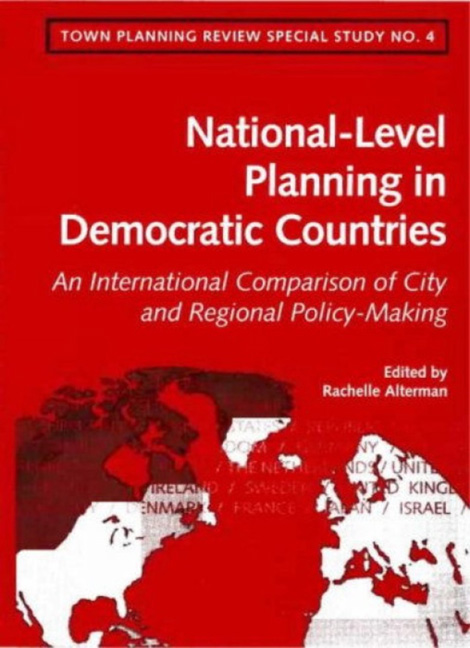 National-Level Spatial Planning in Democratic Countries
National-Level Spatial Planning in Democratic Countries Book contents
- Frontmatter
- Dedication
- Contents
- List of Figures
- List of Tables
- Preface
- About the Contributors
- 1 National-Level Planning in Democratic Countries: A Comparative Perspective
- 2 National Land-Use Planning and Regulation in the United States: Understanding its Fundamental Importance
- 3 Structures for Policy-Making and the Implementation of Planning in the Republic of Ireland
- 4 Rethinking Swedish National Planning
- 5 National-Level Institutions and Decision-Making Processes for Spatial Planning in the United Kingdom
- 6 National-Level Planning Institutions and Decisions in the Federal Republic of Germany
- 7 National-Level Planning in the Danish System
- 8 National-Level Planning Institutions and Decision-Making in France
- 9 National-Level Economic and Spatial Planning in Japan
- 10 Dutch National Planning at the Turning Point: Rethinking Institutional Arrangements
- 11 National-Level Planning in Israel: Walking the Tightrope Between Government Control and Privatisation
3 - Structures for Policy-Making and the Implementation of Planning in the Republic of Ireland
- Frontmatter
- Dedication
- Contents
- List of Figures
- List of Tables
- Preface
- About the Contributors
- 1 National-Level Planning in Democratic Countries: A Comparative Perspective
- 2 National Land-Use Planning and Regulation in the United States: Understanding its Fundamental Importance
- 3 Structures for Policy-Making and the Implementation of Planning in the Republic of Ireland
- 4 Rethinking Swedish National Planning
- 5 National-Level Institutions and Decision-Making Processes for Spatial Planning in the United Kingdom
- 6 National-Level Planning Institutions and Decisions in the Federal Republic of Germany
- 7 National-Level Planning in the Danish System
- 8 National-Level Planning Institutions and Decision-Making in France
- 9 National-Level Economic and Spatial Planning in Japan
- 10 Dutch National Planning at the Turning Point: Rethinking Institutional Arrangements
- 11 National-Level Planning in Israel: Walking the Tightrope Between Government Control and Privatisation
Summary
Background on Ireland
With a land area of 70 282 square kilometres and a population of 3.62 million people, the Republic of Ireland is both one of the smallest and one of the least densely populated member states of the European Union. In European terms the country has been relatively poor and it constitutes a single Objective I region for assistance under EU structural funding programmes (i.e. less than 75 per cent of EU average per capita gross domestic product [GDP] in 1993).
Traditionally a predominantly rural society with a high dependence on agriculture, the country has undergone major economic and social transformations since the dawning of the ‘modern era’ in 1958. The population has increased from 2.8 million in 1961 to 3.62 million in 1996. Perhaps more significant has been the increased share of population in the younger age groups—approximately 43 per cent of the population is now under twenty-five years of age. The country is now experiencing rapid increases in both the rates of household formation and in the numbers entering the labour force (Bannon and Greer, 1998).
In terms of occupation and economic structures, the country has been radically transformed. Up to the 1950s, the Irish economy was inward looking and essentially closed. Post-war policies have redressed this situation, making Ireland one of the more open economies in the world as it seeks both to attract foreign investment and to market its products and services throughout the world. Exposure to free trade and to world competition has profoundly changed the composition of economic activity. Thus, the share of employment in agriculture has fallen from 42.9 per cent in 1949 to only 11 per cent in 1995. While the share of employment in industry has increased from 21.5 to 28.3 per cent over the same period, the hallmark of modern Ireland has been the growth of employment in service activities—increasing from 35.6 per cent of total employment in 1949 to 60.7 per cent in 1995. The growth of industry and industrial output reflects the role of direct foreign investment in the economy, particularly in the mid-1990s, while regional assistance has helped to spread such investment across the country. The growth of services is a reflection of the changing nature of production and the role of services in exports, both directly and indirectly.
- Type
- Chapter
- Information
- National-Level Spatial Planning in Democratic CountriesAn International Comparison of City and Regional Policy-Making, pp. 65 - 84Publisher: Liverpool University PressPrint publication year: 2001


